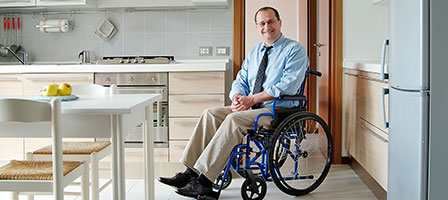IMPAIRMENT-RELATED MEDICAL EXPENSES
Amounts paid for special equipment installed in the home or for improvements may be included in medical expenses, if their main purpose is medical care for the taxpayer, the spouse, or a dependent. The cost of permanent improvements that increase the value of the property may be partly included as a medical expense. The cost of the improvement is reduced by the increase in the value of the property. The difference is a medical expense. If the value of the property is not increased by the improvement, the entire cost is included as a medical expense.
Certain improvements made to accommodate a home to a taxpayer’s disabled condition, or that of the spouse or dependents who live with the taxpayer, do not usually increase the value of the home and the cost can be included in full as medical expenses. These improvements include, but are not limited to, the following items:
- Constructing entrance or exit ramps for the home,
- Widening doorways at entrances or exits to the home,
- Widening or otherwise modifying hallways and interior doorways,
- Installing railings, support bars, or other modifications,
- Lowering or modifying kitchen cabinets and equipment,
- Moving or modifying electrical outlets and fixtures,
- Installing porch lifts and other forms of lifts but generally not elevators,
- Modifying fire alarms, smoke detectors, and other warning systems,
- Modifying stairways,
- Adding handrails or grab bars anywhere (whether or not in bathrooms),
- Modifying hardware on doors,
- Modifying areas in front of entrance and exit doorways, and
- Grading the ground to provide access to the residence.
Only reasonable costs to accommodate a home to a disabled condition are considered medical care. Additional costs for personal motives, such as for architectural or aesthetic reasons, are not medical expenses.
Keep in mind that taxpayers can only deduct medical expenses if they itemize their deductions. Medical expenses are only deductible if they exceed 10% (was 7.5% prior to 2013) of a taxpayer’s income (AGI), and then only the amount that exceeds that income limit is actually deductible. For seniors (age 65 or older and their spouses) the limitation remains at 7.5% through 2016. The table below reflects the AGI limitation for various years:
|
2012 & Before
|
2013-2016
|
After ’16
|
|
| Individuals Under the age of 65 |
7.5%
|
10%
|
10%
|
| Individuals (and their spouses) age 65 before close of year |
7.5%
|
7.5%
|
10%
|
| Alternative Minimum Tax Threshold |
10%
|
10%
|
10%
|








Leave a Reply
Want to join the discussion?Feel free to contribute!